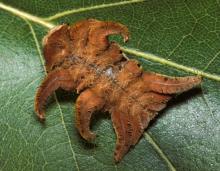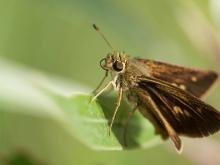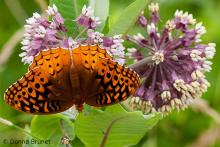Butterflies and Moths
Media

Species Types
Scientific Name
More than 20 species in Missouri
Description
Adult slug caterpillar moths are heavy-bodied and furry. The weird-looking caterpillars have suckers instead of prolegs, so they glide around like slugs. Don’t touch — many have stinging spines or hairs.
Media

Species Types
Scientific Name
Estigmene acrea
Description
The salt marsh moth, a type of tiger moth, is strikingly white with small black spots. Males have yellow-orange hindwings. The caterpillars are fast-moving woolly bears ranging from yellowish to brown to blackish.
Media

Species Types
Scientific Name
Subfamily Herminiinae
Description
Litter moths are a subfamily of rather nondescript brownish moths, often with intricate patterns that camouflage them as they rest on tree bark or among leaves on the forest floor.
Media

Species Types
Scientific Name
Pediasia trisecta
Description
Sod webworms are very common small moths that develop as caterpillars among the roots and leaves of grasses. They are attracted to lights at night.
Media

Species Types
Scientific Name
Eacles imperialis
Description
The beautiful imperial moth is impossible to confuse with any other species in Missouri: the wings are yellow with spots and speckles of pink, orange, or rusty pale purple. Wingspan can be 5½ inches.
Media

Species Types
Scientific Name
Patalene olyzonaria
Description
The juniper-twig geometer is one of many geometrid moths that look like a dried-up leaf. Look for them around porch lights April through November. Larvae eat junipers, including eastern red cedar.
Media

Species Types
Scientific Name
About 275 species in North America north of Mexico
Description
At first glance, skippers look halfway between butterflies and moths. They are commonly seen darting among the flowers they visit on hot summer days.
Media

Species Types
Scientific Name
More than 700 species in North America north of Mexico
Description
Learn about butterflies and skippers as a group. What makes a butterfly a butterfly? How are they different from moths? What are the major groups of butterflies?
Media

Species Types
Scientific Name
Speyeria cybele
Description
The great spangled fritillary is common and easily recognized. This glorious butterfly is often seen in city yards and gardens as it seeks flowers.
Media

Species Types
Scientific Name
Nymphalis antiopa
Description
The unmistakable mourning cloak is a familiar woodland butterfly in Missouri. Adults hibernate and are sometimes seen flying on warm, sunny days in winter.
See Also


Media

Species Types
Scientific Name
About 1,500 species in North America north of Mexico
Description
Adult caddisflies are mothlike. Their larvae are aquatic and build portable, protective cases out of local materials, including grains of sand, bits of leaves and twigs, and other debris.
Media

Species Types
Scientific Name
Corydalus cornutus
Description
Adult eastern dobsonflies are huge and mothlike, with large wings and a weak, fluttery flight. The fiercely predaceous aquatic larvae, called hellgrammites, are well-known to anglers, who often use them as bait.
About Butterflies and Moths in Missouri
Butterflies, skippers, and moths belong to an insect order called the Lepidoptera — the "scale-winged" insects. These living jewels have tiny, overlapping scales that cover their wings like shingles. The scales, whether muted or colorful, seem dusty if they rub off on your fingers. Many butterflies and moths are associated with particular types of food plants, which their caterpillars must eat in order to survive.





















